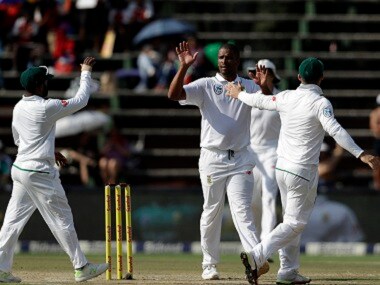Vernon Philander took a huge stride forward, met Nathan Lyon’s flighted delivery with a clean golf swing of his willow and sent the cherry soaring into the third tier of the New Wanderers Stadium. South Africa’s lead in the second innings had been established; it was well over 500, and a seriously depleted Australian outfit could only dream of chasing those runs down. Why then was South Africa still batting? According to their official Twitter handle, Kagiso Rabada had a stiff back, Morne Morkel had a side strain and Philander, tonking sixes off Lyon for fun, had a strapped groin. But just when it felt like one of Temba Bavuma or Vernon Philander would challenge Brian Lara’s Test record against a toothless Australian attack, the declaration finally came. Australia were set a target of 612 runs, and South Africa had to bowl a further 120 overs. Day 4 ended with Morkel snaring two wickets despite a side strain, while Philander had a catch dropped off his bowling. [caption id=“attachment_4417597” align=“alignleft” width=“380”]  Vernon Philander celebrates with his South African teammates. AP[/caption] On the final day, the injury-hampered quicks were aided by Keshav Maharaj and his guile. They complemented each other, helped each other and attacked the Aussies like a pack of hungry wolves. They all realised there would be days when individuals would have to play second-fiddle to help each other out. Speaking ahead of the final Test against India earlier this year at the same Wanderers ground, a Test where the hosts had fielded a four-man pace attack, Philander had spoken of the need to set one’s ego aside. “It’s all about understanding the role that you play within the attack. We are four seamers, so we want to keep it as tight as possible and bowl them out as cheaply as possible. It’s about finding your role in the four-pronged attack and making sure you deliver what is required of you. You have to put your ego aside, we all want to be the hero at the end of the day,” Philander had said. Against Australia three months later, that wasn’t the case — with Maharaj available here to let the fast bowlers rest their tired legs. But Philander would have none of it on Day 5. The seamer kept up a nagging 125-kilometres per hour spell on the final morning, a badass spell reminiscent of his Test debut seven years ago, against the same team at Cape Town. Then, Philander and Co. ripped through the entire Aussie line-up in just 18 overs, bowling them out for an embarrassing 47 runs, the debutant taking 5/15. On Tuesday morning, it took the Proteas 17 overs — eight of them bowled by Philander — to knock over the seven remaining Australian wickets for just 31 additional runs. The action unfolded quicker than a 90-minute edge-of-the-seat thriller. It started the very first ball of the day, when Philander put Shaun Marsh out of his misery with one that seamed in and caught the southpaw off guard. Like in the first innings, one Marsh brother followed the other. Mitchell Marsh succumbed to another Philander jaffa, as the seamer completed his 200th wicket in his 54th Test, becoming the fourth fastest South African to reach the landmark. Handscomb, Paine, Cummins and Sayers followed as Philander wrecked havoc despite with little assistance from the Wanderers surface. CricViz estimated that he found lesser swing and seam than the average movement in the whole Test, but when you have the accuracy of an ace archer, why would you need any kind of movement? He induced an estimated 31 percent false shots as Australia grappled around — not for the first time — to salvage broken pride. Six of the seven wickets to fall in the final day fell to the relentless pacer, a terrific turnaround when compared to his low strike rate in the last few matches. Since destroying India at Cape Town with a nine-wicket haul in the first match of the home series in January, Philander sent down 164.1 overs across five Tests (before Wanderers), picking up just 13 wickets at a strike rate of 75.7. “We all want to put up our hand to be ‘Man of the Match’, but not every surface is going to allow that. It is about being mature enough to understand that your end might not be the one to strike from and to play your role accordingly to make sure the other bowlers get the best conditions to strike,” Philander had said during the Indian series. Despite the conditions not favouring him this time, Philander knew his role. He decided to stick to his process and if it isn’t his “end”, so be it. His average speed in the series (127.56 kilometres per hour according to CricViz) was among his lowest in series involving more than two Tests. His process remains the same irrespective of opposition, ground, swing, pace or seam. “For me, it’s all about the timing, when to strike, because I’ll hold, hold, hold, hold and then (clicks his fingers), I’ll decide that it’s time. You need to try and sense the perfect opportunity to do that, and then be able to deliver that one specific ball,” Philander had once said, revealing his successful bowling methods in an interview to ESPN Cricinfo. On Tuesday, as the stars aligned in his favour, Philander breathed fire on his favourite opponents, to end with a ‘Man of the Match’ award and a career-best haul of 6/21. It was only fitting that it came in a 492-run victory that sealed the Proteas’ first series win against Australia since re-admission.
On Tuesday morning, it took South Africa 17 overs — eight of them bowled by Philander — to knock over the seven remaining Australian wickets for just 31 additional runs
Advertisement
End of Article


)

)
)
)
)
)
)
)
)



